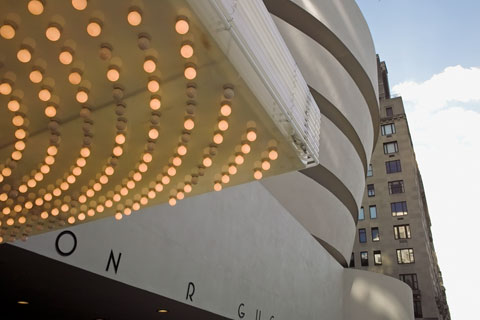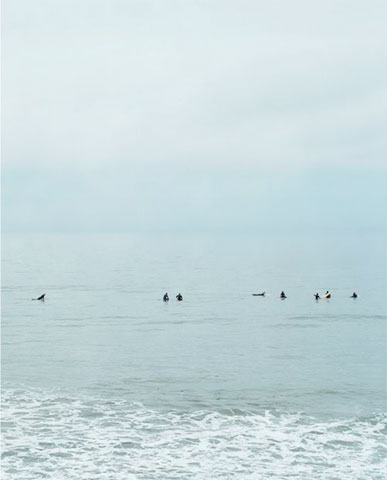
The Guggenheim Museum, Marquee by Philippe Parreno
© Brian Rose
I went to the Guggenheim and Whitney museums to see a couple of photo exhibits–Catharine Opie and Williams Eggleston. The Opie work was relatively unknown to me, and I wanted to see what or why she was given a large retrospective at the Guggenheim. Her career was launched by gender identity work, portraits of lesbians and transgender individuals, and self-portraits. This stuff seems dated to me at this point, which means I think it’s work with a limited shelf life, now expired. The poses are wooden, the references to old master painting pretentious. But I give Opie credit for giving visibility to people who are at the margins of mainstream society.

Opie exhibit at the Guggenheim
I liked the ice houses and surfers waiting for waves in one of the galleries–not so much the individual images, but the way they were lined up to form multi-panel panoramas. There’s a lot of textual mumbo jumbo accompanying these beautiful pieces, however, and they would be better off without it.
Around the time that this series was completed she summarized her artistic project: “I concentrate on disturbing the devices that society imposes on variant communities to keep them ‘ghettoized’ by class, race, sexuality, and gender. It’s important that my work be seductive as a visual language, as I want to keep the viewer engaged. This allows for multiple readings which challenge viewers to consider both people and space in their various complexities.”
What I like about the two series is the way in which the panoramas are comprised of individual images made at different times. The line of surfers never exisited in real time as seen across the panels, and there is a progression from fogginess on one side to clearer images on the other. Only a few surfers are shown riding the waves–most paddle about waiting for a wave.
The freeway flyovers and empty city street photographs do not connect with me. They suggest meaning that I do not think is sustained in the images.
We’ve somehow lost sight of what America was originally. Think about the power of Ellis Island, the melting pot, and how all that is disappearing in favor of white-bred America. . . . America’s not about multiculturalism anymore. And that’s what I mean, that cities still hold this utopian notion of what America once was.” To help bring home this sense of loss, starting with St. Louis, she once again portrayed her chosen cities bereft of their populations.
I don’t agree with the statement about white-bred America. We just elected a black president, and we are gradually becoming less white, less homogeneous.

Opie exhibit at the Guggenheim, (digital) © Brian Rose
The domestic series–large scale images of lesbians in family/home situations–is not as compelling as the intention implied. There’s supposed to be a tension between the ordinariness of the activities in the pictures and the extra-ordinariness of the couples and families depicted. OK, I get it. I do like the image of the pregnant woman floating in a pool–heaviness and weightlessness. But too much of Opie’s work is about telling rather than allowing the viewer to discover.
There’s a ton of laudatory opinion about Opie on the Internet, much of it from the star making machinery of the art world. Feel free to Google.
On to William Eggleston at the Whitney.